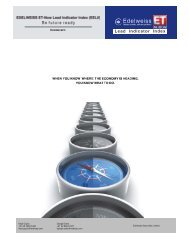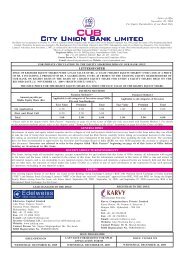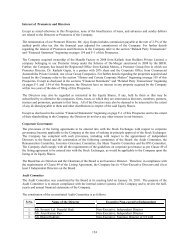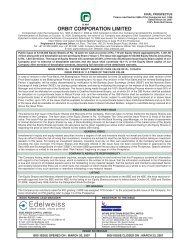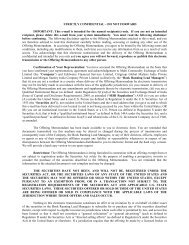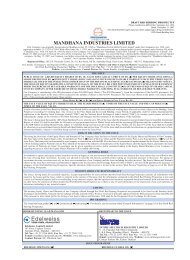Annexure XIV Continued⦠- Edelweiss
Annexure XIV Continued⦠- Edelweiss
Annexure XIV Continued⦠- Edelweiss
You also want an ePaper? Increase the reach of your titles
YUMPU automatically turns print PDFs into web optimized ePapers that Google loves.
have the fuel resources required to operate such facilities and that have the infrastructure to transmit power to<br />
deficit regions in India. For further details, please see the section titled "Our Business – Power Generation<br />
Business – Power Projects under Construction, Implementation and Development" on page 157 of this Draft<br />
Red Herring Prospectus.<br />
Significant Factors Affecting our Results of Operations<br />
Our financial condition and results of operations are affected by numerous factors, the following of which are<br />
of particular importance:<br />
Increased coal production and demand for beneficiated coal<br />
Our coal beneficiation business has benefited from a period of sustained economic growth and an increase in<br />
the production of coal in India. According to the Ministry of Coal, coal production in India grew at a CAGR of<br />
6.80% from 2004-05 to 2009-10 (Source: CRISIL Research Review and Outlook on Power and Coal, April<br />
2011). Moreover, Coal India Limited and its subsidiaries, which produce most of the coal in India and from<br />
whom our customers purchase most of their coal, increased its production of Grade "F" coal from 153.01<br />
million tons in Fiscal 2007 to 191.89 million tons in Fiscal 2010. Raw coal in India is generally "F" grade,<br />
which has an ash content of approximately between 36% and 45%. Demand for beneficiated coal has increased<br />
because power plants located more than 1,000 kilometres from the coal mine that supplies them are legally<br />
required to use coal with an ash content of not more than 34% as their fuel. Power plants located in critically<br />
polluted areas, urban areas and ecologically sensitive areas are also restricted in the same manner. For further<br />
details, please see the section titled "Regulations and Policies in India" on page 178 of this Draft Red Herring<br />
Prospectus. The only way to decrease the ash content of raw coal is to beneficiate it or blend it with coal of a<br />
sufficiently low ash content. The sustained economic growth in India has also increased demand from our<br />
customers, most of whom are public sector thermal generation companies and utilities, for beneficiated coal.<br />
Demand can also be impacted by the location, availability, quality and price of alternative energy sources for<br />
power generation, such as natural gas, fuel oil, nuclear, hydroelectric, wind and solar power.<br />
The increased production of coal requiring, in certain circumstances, beneficiation, combined with the<br />
increased demand for coal in India as a result of economic growth, has impacted the growth in our coal<br />
beneficiation revenue. In Fiscal 2006 our coal beneficiation revenue was ` 2,308.74 million compared to `<br />
3,508.04 million in Fiscal 2010, reflecting a CAGR of 11.03% over the period.<br />
Increases in our coal beneficiation capacity<br />
We have been able to benefit from the increase in the supply of coal and demand for beneficiated coal in part<br />
by expanding our coal beneficiation capacity, particularly in areas that are characterized by having both<br />
significant supplies of coal and demand for energy. For example, two of Coal India Limited's principal<br />
subsidiaries, South Eastern Coal and Mahanadi Coalfields Limited, have substantial mining operations in<br />
Chhattisgarh and Orissa, respectively, where we have increased our aggregate proportional beneficiation<br />
capacity from 2.5 million tons per annum as of March 31, 2002 to 53.46 million tons per annum as of<br />
December 31, 2010. Transporting raw coal from the mine to our coal beneficiation plants and from the plants<br />
to our customers is expensive and requires adequate infrastructure, some of which we must develop ourselves<br />
or negotiate with local governments to have developed. Consequently, the availability of land close to mines<br />
and rail and road infrastructure, and developing coal beneficiation plants near mines and infrastructure, are two<br />
of the most significant factors affecting our results of operations.<br />
The table below sets forth for the periods indicated our number of coal beneficiation plants, our effective<br />
economic interest in the capacity and the amount of coal beneficiated.<br />
Particulars Fiscal 2002 Fiscal 2005 Fiscal 2007<br />
Nine months<br />
ended December<br />
31, 2010<br />
Number of plants (1) .................... 1 3 7 (3) 15 (4)<br />
Effective Economic Interest in the<br />
Capacity (1)(2) 2.5 12.62 21.32 53.46<br />
Coal beneficiated ...................... 2.29 10.53 13.78 19.84<br />
__________<br />
(1) At period end.<br />
281




